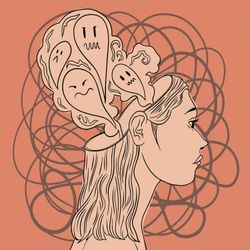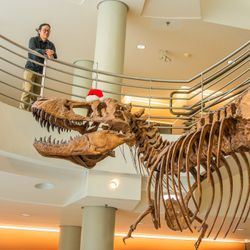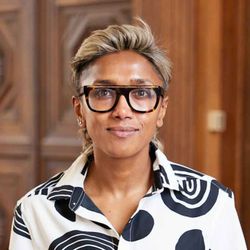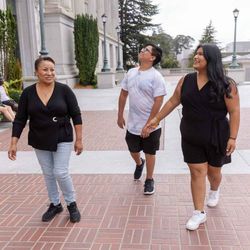Share

Berkeley Voices
93: How the Great Migration transformed American music
Between 1910 and 1970, about 6 million Black Americans moved from the rural South to cities in the North, the West and other parts of the United States. It’s known as the Great Migration. Musicians who moved to these cities became ambassadors, says UC Berkeley history professor Waldo Martin, “not only for the music of the South, but for the culture from which the music emerged. And the music was made and remade, and continues to be today. On Feb. 17, mezzo-soprano Alicia Hall Moran and jazz pianist Jason Moran — and an all-star roster of jazz collaborators — will perform their remaking of the music in Two Wings: The music of Black America in Migration for UC Berkeley’s Cal Performances.
Listen to the episode, read a transcript and see photos on Berkeley News.
If you haven't already, follow Berkeley Voices and review us on Apple Podcasts and Spotify!
(UC Berkeley illustration by Neil Freese)
More episodes
View all episodes

127: How fear is being weaponized against you (and how to respond)
22:33|Against her mom’s warnings, UC Berkeley political scientist Marika Landau-Wells watched Arachnaphobia as a kid. Ever since, she has been terrified of spiders. But over the years, she has learned to reason with her quick fear response — No, that spider is not 8 feet in diameter — and calmly trap them and put them outside.We all encounter problems like this, she says, where we have quick reactions to things we’ve learned to fear. It might be something that is actually dangerous that we really should quickly react to, but it could also be a tiny, non-threatening spider. Each time, we have to decide what kind of problem it is and then how to respond. She says this task is especially hard today because we're inundated with messages trying to hijack our fear response, from junky online ads to the way politicians speak.Landau-Wells studies how we make these kinds of decisions, and what influences how we act, especially in situations where there’s a lot on the line.This is the fourth episode of our eight-part series on transformation. In eight episodes, we’re exploring how transformation — of ideas, of research, of perspective — shows up in the work that happens every day at UC Berkeley. New episodes of the series come out on the last Monday of each month. See all episodes of the series.Key takeaways:We learn what to be afraid of; once we fear something, it’s hard to change our perception.We’re bombarded with messaging trying to hijack our quick fear responses.Research on how the brain processes fear could help us persuade people to see dangers differently and influence how world leaders make decisions.Listen to the episode and read the transcript on UC Berkeley News (news.berkeley.edu/podcasts).Music by Blue Dot Sessions.Image by Sara Oliveira/Unsplash+
126: Think you know what dinosaurs were like? Think again.
18:09|For UC Berkeley Professor Jack Tseng, the world of paleontology never gets old. With each new discovery, paleontologists like him learn more about the animals that walked the earth millions of years ago."If you look at books from 50 years ago, they postured dinosaurs very differently from the way we do it today," Tseng says. "This constant profusion of new scientific knowledge into the popular psyche is recorded in children's books, which is a lovely way to see how this science has progressed."Fossils also hold valuable clues about our planet's future and our role within it as we experience climate change, he says."The questions we ask of them have to do with how different species sometimes survive, when others go extinct. Paleontology is sort of pre-adapted to plug in to understanding the future of Earth because we have billions of years of the fossil record to learn from."This season on Berkeley Voices, we’re exploring the theme of transformation. In eight episodes, we’re exploring how transformation — of ideas, of research, of perspective — shows up in the work that happens every day at UC Berkeley. New episodes will come out on the last Monday of each month, from October through May. See all episodes of the series.Key takeaways: Paleontologists can better understand how dinosaurs and other prehistoric animals looked and lived by studying living animals.New discoveries have reshaped what we thought we knew about dinosaurs and the prehistoric world.Fossils hold clues about the role of different species of plants and animals during climate change — and the future of Earth.Listen to the podcast and read the transcript on UC Berkeley News (news.berkeley.edu/podcasts).Music by Blue Dot Sessions.UC Berkeley photo by Stanley Luo.
125: As crises escalate, so does our fascination with cults
29:10|Like millions of other Americans, UC Berkeley Professor Poulomi Saha watched a lot of docuseries about cults during the COVID-19 pandemic. The more Saha watched, the more they felt a kind of change within themself. "I was absolutely enthralled," said Saha. “My reaction no longer fit that old script, the script that I had internalized. I wasn’t just having a passing interest. I wasn’t sort of mildly terrified. I was thinking, “Oh, wow, that makes good sense.’” Saha wanted to understand why. So they started a class, called Cults in Popular Culture, where Saha and their students explore the history of cults, the transformative power of these groups and the conditions that give rise to our collective fascination. After all, Saha says, what better way to make sense of this phenomenon than to ask several hundred Berkeley undergraduates to be test subjects?This season on Berkeley Voices, we're exploring the theme of transformation. In eight episodes, we’re exploring how transformation — of ideas, of research, of perspective — shows up in the work that happens every day at UC Berkeley. New episodes will come out on the last Monday of each month, from October through May. See all episodes of the series.Key takeaways: Nobody joins a cult; they join a good thing. It’s labeled a cult when it goes bad.Our fascination with cults rises amid social and global crises. It happened in 1960s America and it’s happening today. The IRS decides the difference between a religion and a cult. A person who joins a so-called cult undergoes a transformative experience. Instead of calling them "crazy," we should listen.Listen to the podcast and read the transcript on UC Berkeley News (news.berkeley.edu/podcasts).Music by Blue Dot Sessions.UC Berkeley photo by Jen Siska.
124: Psychopathy goes undetected in some people. Why?
23:11|In a June 2024 study, UC Berkeley psychology professor Keanan Joyner and his colleagues found that by using a combination of methods tailored to the multidimensional nature of psychopathy, we could transform how we identify and understand this personality disorder. "I think that it goes toward having a functional and positive society," Joyner said. "Our collaboration is the substance of what makes humans so wonderful as a species."Key takeaways:- Psychopathy exists on a spectrum- Boldness is a key, yet largely overlooked, trait of psychopathy- By changing the way we measure psychopathy, we could reduce the harms of the personality disorderThis year on Berkeley Voices, we're exploring the theme of transformation. In eight episodes, we’ll explore how transformation — of ideas, of research, of perspective — shows up in the work that happens every day at UC Berkeley. New episodes will come out on the last Monday of each month, from October through May.See all episodes of the series.Listen to the episode and read the transcript on UC Berkeley News (news.berkeley.edu/podcasts).Music by Blue Dot Sessions.Image via Unsplash+
123: One brain, two languages
13:21|For the first three years of Justin Davidson's childhood in Chicago, his mom spoke only Spanish to him. Although he never spoke the language as a young child, when Davidson began to learn Spanish in middle school, it came very quickly to him, and over the years, he became bilingual.Now an associate professor in UC Berkeley's Department of Spanish and Portuguese, Davidson is part of a research team that has discovered where in the brain bilinguals process and store language-specific sounds and sound sequences. The research project is ongoing.This is the final episode of a three-part series with Davidson about language in the U.S. Listen to the first two episodes: "A linguist's quest to legitimize U.S. Spanish" and "A language divided."Photo courtesy of Justin Davidson.Music by Blue Dot Sessions.Listen to the episode and read the transcript on Berkeley News (news.berkeley.edu).
122: A language divided
11:58|There are countless English varieties in the U.S. There's Boston English and California English and Texas English. There's Black English and Chicano English. There's standard academic, or white, English. They're all the same language, but linguistically, they're different."Standard academic English is most represented by affluent white males from the Midwest, specifically Ohio in the mid-20th century," says UC Berkeley sociolinguist Justin Davidson. "If you grow up in this country and your English is further away from that variety, then you may encounter instances where the way you speak is judged as less OK, less intelligent, less academically sound."And this language bias and divide can have devastating consequences, as it did in the trial of George Zimmerman, who killed 17-year-old Trayvon Martin in 2012. This is the second episode of a three-part series with Davidson about language in the U.S. Listen to the first and third episode: "A linguist's quest to legitimize U.S. Spanish" and "One brain, two languages."Listen to the episode and read the transcript on Berkeley News (news.berkeley.edu/podcasts).Music by Blue Dot Sessions.AP photo by Jacob Langston.
121: A linguist's quest to legitimize U.S. Spanish
11:24|Spanish speakers in the United States, among linguists and non-linguists, have been denigrated for the way they speak, says UC Berkeley sociolinguist Justin Davidson. It’s part of the country's long history of scrutiny of non-monolingual English speakers, he says, dating back to the early 20th century."It’s groups in power — its discourses and collective communities — that sort of socially determine what kinds of words and what kinds of language are acceptable and unacceptable," says Davidson, an associate professor in the Department of Spanish and Portuguese.But the U.S. is a Spanish-speaking country, he says, and it’s time for us as a nation to embrace U.S. Spanish as a legitimate language variety.This is the first episode of a three-part series with Davidson about language in the U.S. Listen to other two episodes: "A language divided" and "One brain, two languages."Listen to the episode and read the transcript on Berkeley News (news.berkeley.edu).Photo by Brittany Hosea-Small.Music by Blue Dot Sessions.
120: Medieval song holds clues to lost dialects
18:25|In his research, UC Berkeley Ph.D. candidate Saagar Asnani looks at music manuscripts from between the 12th and 14th centuries in medieval France. He says only recently have scholars begun to use a wider variety of media and artistic expressions as a way to study language. "If we unpack the genre of music, we will find a very precise record of how language was spoken," Saagar says. To read medieval music, Saagar learned five languages — Latin, German, Italian, Catalan and Occitan — making 10 languages that he knows in total (for now, at least). In losing the history of pieces of music, Saagar says, we’ve lost languages and cultures that were present and important to the time period. And today, at a time when linguistic boundaries are crumbling before our eyes, he says, instead of judging someone who speaks differently from you, realize that “it's actually a way of speaking a language and that we should cherish that because it's beautiful in its own way."Listen to the episode and read the transcript on Berkeley News (news.berkeley.edu/podcasts).UC Berkeley photo by Brandon Sánchez Mejia.
119: Art student's photo series explores masculine vulnerability
08:59|Brandon Sánchez Mejia stood at a giant wall in UC Berkeley’s Worth Ryder Art Gallery and couldn’t believe his eyes. In front of him were 150 black-and-white photos of men’s bodies in all sorts of poses and from all sorts of angles. It was his senior thesis project, "A Masculine Vulnerability," and it was out for the world to see."It came from this idea that as men, we are not allowed to show skin as scars or emotions or weakness," said Sánchez, who will graduate from Berkeley this May with a bachelor’s degree in art practice.Sánchez’s cohort is part of the Department of Art of Practice’s 100th year, a milestone that department chair Ronald Rael said is cause for celebration."There have been moments in art practice’s history when it was unclear that art should be at a university at all," said Rael, a professor of architecture and affiliated faculty in art. "And here we are, at 100 years, and it’s one of the most popular majors on campus."Listen to the episode and read the transcript on Berkeley News (news.berkeley.edu). This is a companion podcast to a feature story about Sánchez, published earlier this month on Berkeley News. There, you can view more photos and read about about how Sánchez's mom made him stay inside for a year as a teenager in El Salvador out of fear he'd join a gang. And how, against his mom's wishes and without any money of his own, he decided to pursue an education — no matter what it took. UC Berkeley photo by Keegan Houser. Music by Blue Dot Sessions.